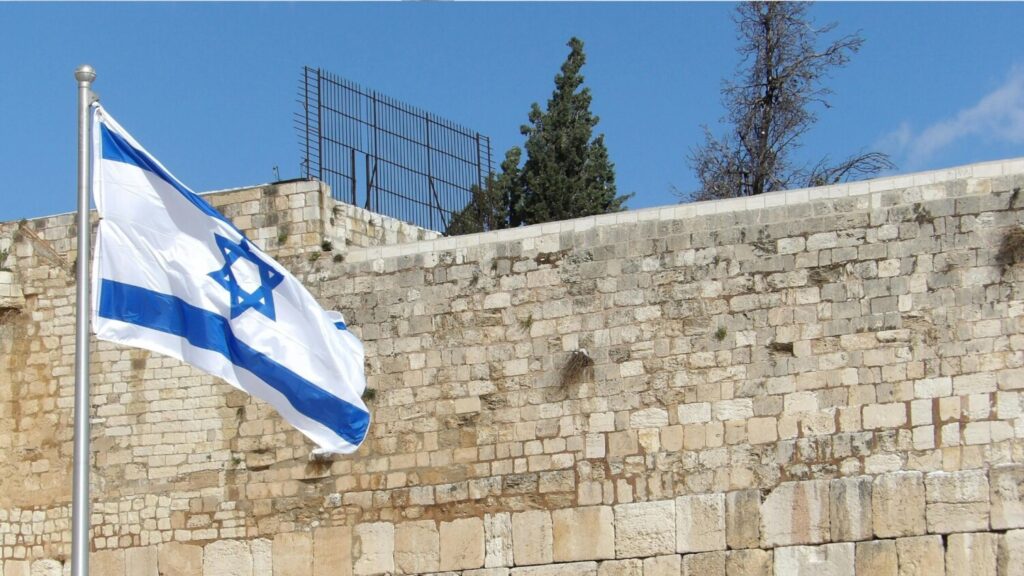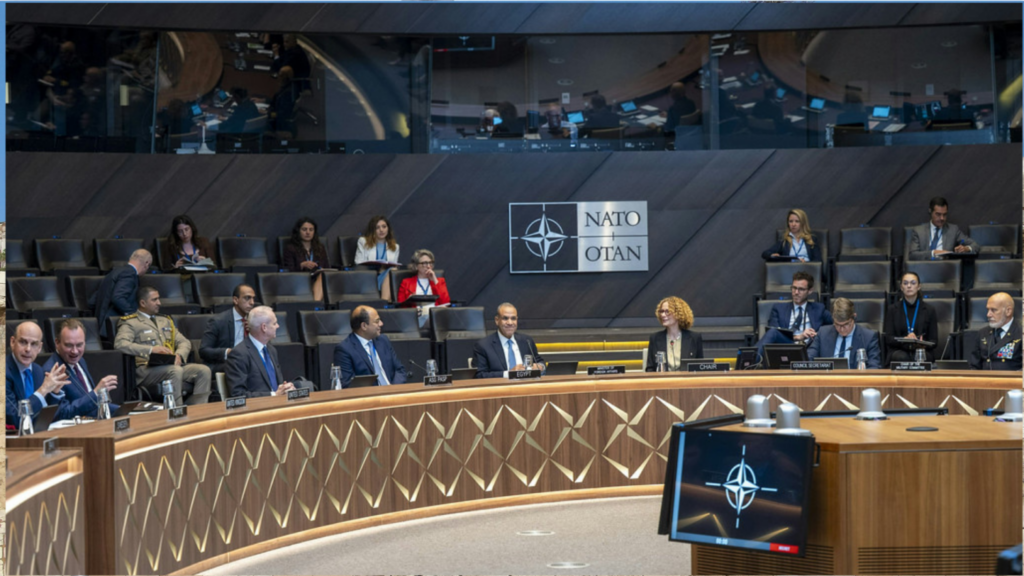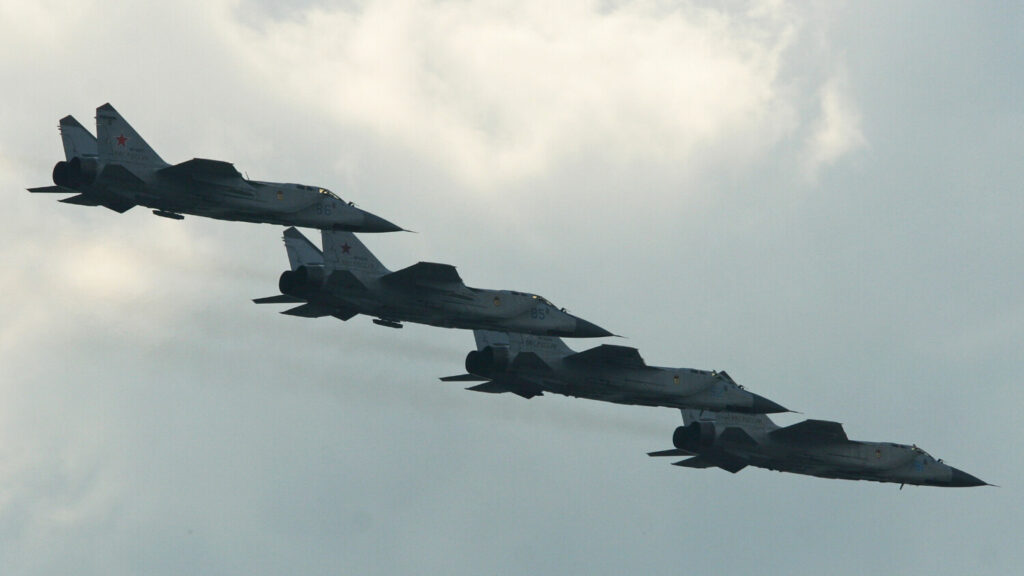Exploring Mali’s Jihad
The Malian coup on August 18 briefly brought the West African nation to international attention. However, its problems run deeper and are more intractable than the ambitions of a group of army officers. As the Council for Foreign Relations recently noted: ‘An estimated half of Mali’s population lives in severe poverty, ethnic divisions are chronically unaddressed, and Islamist jihadis roam much of the northern half of the country. Those realities are unlikely to change as a result of a coup’.
The problem is not limited to Mali. Armed conflict and violence against civilians across the region is rampant. The African Union, despite setting itself the ambitious aim to ‘silence the guns’ across the continent, has thus far failed to stem the violence in West Africa.
Perhaps more worryingly for the US and its NATO allies, especially France, resources committed to West Africa have done little to stem the proliferation of violence linked to the expansion of jihadist groups in the West African region. Not only has the French intervention, under the guise of ‘Operation Barkhane’, in an area of historical interest failed in its objectives to restore sovereignty to the parts of Mali in the grip of al-Qaeda linked groups, but the campaign has been described as ‘France’s Afghanistan’, highlighting the frustrations created by a determined Islamist insurgency.
Recognising that transnational jihadism cannot be solved at a local or even national level, the so-called G5 including Burkina Faso, Mauritania, Mali, Niger and Chad, backed by the EU, formed a Joint Force in 2014 as a security coalition to foster economic growth and counter the Islamist threat in the region. However, the inability to join up the military and development efforts have thus far precluded any meaningful advances. As the graph shows, violent incidents in Mali, linked to the activities of a plethora of jihadist groups, have increased in recent years:
From the International to the Local
The French involvement in Mali increased to 5,100 in 2020 following the formal recognition that the Islamic State in Greater Sahara (ISGS) represents the greatest security threat to the G5. Britain also plans to send a small contingent to act as the UN Peacekeeping Operation’s long-range reconnaissance capability. The UN has 15,500 troops deployed to support the 2015 peace accord between the government and two rebel groups, the Coordination of Azawad Movements (CMA) and the Platform of armed groups (the Platform). Interestingly, America’s AFRICOM has been reticent to reveal the extent of US involvement in Mali but it is likely to be minimal and mostly in a non-warfighting capacity.
The battlefield is complicated by intra-jihadist rivalries, particularly between ISGS and the al Qaeda umbrella group Jama’a Nusrat ul-Islam wa al-Muslimin (JNIM). JNIM has shown a willingness to negotiate with the Malian government on the condition that foreign troops leave. ISGS, as in other places, has preferred displays of force over a robust diplomatic strategy. However, as JNIM is constituted of relatively autonomous groups – including Ansar al-Din, al-Qaeda in the Islamic Maghreb, al-Mourabitoun, and Katibat Macina – understanding the makeup of the Malian jihad is difficult.
However, it would be a mistake to view the conflict in Mali as purely ideologically or theologically inspired, or as a copy and pasted rerun of the fight against al Qaeda and ISIS in Iraq and Syria. Local dynamics are extremely important determinants. For example, in Mali’s central Mopti region the competition for natural resources is cited as the primary driver of conflict. As a case in point, a report from Reuters in 2017 found that many ‘jihadists’ had taken up arms to protect their livestock from cattle raiders rather than because of any strong ideological ties to Salafi-Jihadism. Tensions between groups of pastoralists, semi-pastoralists, and sedentary populations have added to a bewilderingly complex situation of intercommunal violence in which the international community has been unable to fully understand, let alone contain. Ethnic divisions are also important. The overrepresentation of Fulani in militant Islamist groups in the Sahel has led to the stigmatisation of the whole ethnic community. This has led to a viscous cycle of attacks against Fulani civilians on one hand, and Dogons and Bambaras on the other.
As the map highlights, Mopti has seen the most violence since 2015 and is therefore this instability that has caused foreign fighters to move to Mali, rather than the other way round.
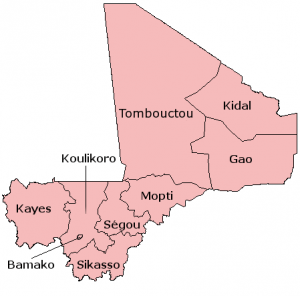
Data Source: ACLED
The Way Forward
Mali and other West African states will need to eventually solve these problems on their own terms. However, evidence alludes to the use of counter-productive strategies across the region. Human Rights Watch (HRW) reported that a mass grave containing the bodies of 180 jihadist fighters in Burkina Faso, some of whom showed clear evidence of being summarily executed. In the same report, Chérif Moumina Sy, a politician from Burkina Faso reported that local populations often can see no difference between the state forces and the rebels. The influential Institute for Security Studies recently made a similar point with regard to the lack of fair trials for Boko Haram fighters in Nigeria.
The situation is no better in Mali. As a Swedish officer, commanding part of the UN Peacekeeping operation in Mali stated to the Financial Times: ‘The social contract between the government and citizens is broken, and religious extremists have come into some of these places and provided these services’. These dynamics where the tactics of the state and the insurgents are similar in nature bears more similarities to a civil war than to a traditional counter-insurgency situation. This benefits the Islamists by allowing them to position themselves as a viable and popular alternative to the state. This can boost support, recruitment and provides a population to hide in. Other dynamics compound these problems of legitimisation.
Other Compounding Problems
Foreign fighters also graft their own goals onto local conflicts. This can compound and exacerbate the ongoing conflict. Crucially, analysts are concerned that ‘career jihadists’ will exploit the situation in Mali and its neighbours to continue the struggle to achieve statehood, expressed by al-Qaeda and briefly achieved by ISIS. Although numbers are extremely difficult to obtain, the case of Algerian fighters is illustrative. Between 2017 and 2019 nearly 200 fighting Algerians have surrendered, implying a far greater number that is still active. When the numbers from Syria, Iraq, Libya and Tunisia, the GCC and Saudi Arabia are added to the mix, there are likely thousands of committed and experienced jihadists operating within Mali.
Food insecurity is also a major problem, linked to a number of intractable problems including climate change and natural disasters, as well as violent conflict. It is no coincidence that Mopti has experienced both a crisis of food security and the most violence within Mali.
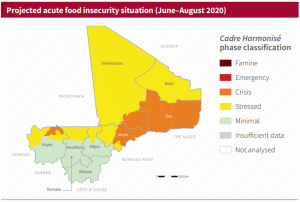
Source: Relief Web
Finally, and as everywhere, the COVID-19 pandemic will make life harder for the Malian government. The health crisis opens up the space for jihadi groups to provide services that the state is unable to. This in turn increases the influence that these groups hold within the population. The combination of the August coup and the vacuum opened up by the pandemic creates the space for jihadist groups to dominate local politics.
Conclusion
Although Mali is not Iraq or Syria, the central lesson from the rise of the Islamic State of Iraq and al-Sham is relevant; jihadist groups thrive where the state fails. It is therefore imperative that the Malian state can carry out an effective counter-insurgency strategy, supported by its regional and international allies, despite the recent coup. Critically, any military strategy needs to be supported by a robust and sustainable plan for economic development that addresses the underlying local problems that have allowed the broader conflict to evolve.

